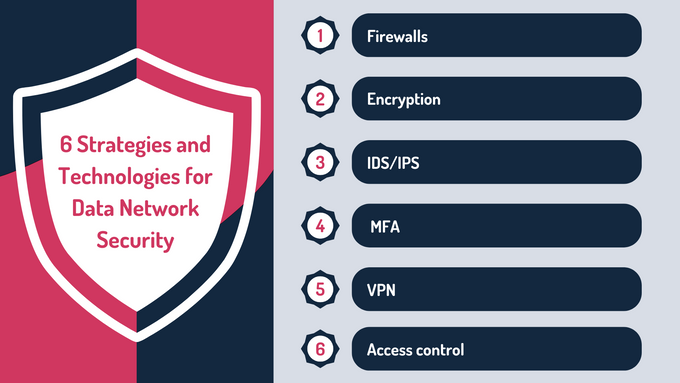Understanding Data Network Security: Key Concepts and Best Practices
Discover key strategies to strengthen your data and network security through effective risk assessments, compliance alignment, and encryption practices.
Published May 18, 2025.

Data and network security is a critical concern for organizations of all sizes, with increasing threats challenging the integrity of sensitive information. Protecting your network involves implementing effective strategies to safeguard against unauthorized access, breaches, and data leaks. Effective security and network management rely on a combination of well-established frameworks and technologies to create a robust defense.
In this blog, we will explore key concepts, best practices, and how you can improve security measures to protect your network.
» Looking for an effective data network security solution for your business? Contact us
What Is Data Network Security?
Data network security is about protecting data both at rest and while it moves through a network. It’s about making sure data stays confidential and its integrity is preserved. This is usually done with encryption tools and firewalls.
» Have a startup? Here are some cyber tips for your startup business
Data Network Security vs. General Network Security vs. Cybersecurity
| Difference | Data Network Security | General Network Security | Cybersecurity |
|---|---|---|---|
| Scope of Focus | Focuses on protecting data as it moves across a network, such as securing emails or payment information using encryption. | Covers the broader network setup, including switches, routers, and access points. | Encompasses the entire digital environment, from securing devices to training users on phishing and other threats. |
| Primary Objective | Aims to keep data secure in transit, ensuring it is not intercepted or altered during transfer. | Focuses on maintaining network stability and preventing attacks on the network infrastructure. | Protects systems, people, and data—whether stored, shared, or physically accessed. |
| Tools and Techniques | Tools include VPNs, HTTPS, and secure tunnels to protect data in motion and support safe remote access. | Relies on access controls, network segmentation, and traffic monitoring to secure the network. | Uses a layered approach involving antivirus software, awareness training, and incident response plans to safeguard the full organization. |
» Don’t leave it too late: Explore the disasters you can avoid by proactively addressing your cybersecurity needs
Evolving Threats Compromising Network Security
Man-in-the-Middle (MitM) Attacks
MitM attacks remain one of the most serious risks to network and security, particularly on public or unsecured networks. In these attacks, cybercriminals intercept communication between two parties, capturing sensitive information such as login credentials or financial data.
How to mitigate the risk
- Use Transport Layer Security (TLS) or VPN protection to secure communications.
- Avoid public Wi-Fi without encryption tools.
- Enforce strong Wi-Fi security protocols (e.g., WPA3).
- Enable multi-factor authentication for sensitive accounts.
» Understand how to secure your external network with regular penetration testing
Phishing-Enabled Network Breaches
Phishing continues to be a primary method for breaching networks. Attackers trick users into clicking malicious links, often disguised as legitimate emails, which then install malware or create a backdoor. This allows unauthorized access to the internal network. Once inside, attackers can access or exfiltrate sensitive data both in transit and at rest.
How to mitigate the risk
- Implement layered security that includes email filtering and malware detection.
- Offer regular awareness training to reduce user error.
- Apply strict access controls across all systems.
- Monitor user behavior for signs of compromise.
» Here's everything you need to know about phishing attacks
Misconfigured Network Devices
Misconfigured firewalls leave ports open, or forgotten admin panels provide easy entry points for attackers or even disgruntled employers. It’s not always malicious, it can be carelessness or lack of expertise.
How to mitigate the risk
- Regularly audit network devices and configurations.
- Implement role-based access controls.
- Secure and monitor administrative panels.
- Review firewall rules and close unnecessary ports.
Insider Data Theft
Insider threats, whether from current or former employees, pose a major challenge to network and security efforts. When access rights are not properly revoked, sensitive information can be copied, altered, or leaked. These individuals may extract or manipulate sensitive data especially if access rights aren’t managed correctly.
How to mitigate the risk
- Apply strong offboarding protocols.
- Regularly review user access permissions.
- Monitor for unusual access patterns.
» Read more: How to secure your internal network with regular penetration testing
6 Strategies and Technologies for Data Network Security
1. Firewalls
Firewalls are the first line of defense in network security. They monitor and control incoming and outgoing network traffic based on predefined security rules.
Primary Objectives
- Prevent unauthorized access while ensuring legitimate traffic flows freely.
- Maintain network integrity and availability by blocking malicious activity.
How it works with other technologies
Firewalls are often paired with intrusion detection systems (IDS) and access controls. Together, they create a robust network perimeter, allowing only authorized traffic while blocking malicious activity, preserving both integrity and availability.
» Exposed ports and weak firewalls invite attackers. Identify security gaps before attackers do
2. Encryption
Encryption is the process of converting data into a coded format, ensuring that sensitive information remains unreadable without the correct decryption key.
Primary Objectives
- Maintain confidentiality by ensuring that only authorized parties can read or modify data, even if it is intercepted.
- Protect sensitive data from unauthorized access during transmission and storage.
How it works with other technologies
Encryption works hand-in-hand with technologies like HTTPS, TLS protocols, and VPNs. These tools secure data transmission and prevent unauthorized parties from accessing sensitive information, thus safeguarding confidentiality. Together, they form a powerful layer in data and network security.
» Make sure you understand the difference between asymmetric and symmetric encryption
3. Intrusion Detection and Prevention Systems (IDS/IPS)
IDS and IPS are network security technologies that monitor network traffic for signs of malicious activity.
Primary Objectives
- IDS detects potential threats by identifying patterns or signatures of known attacks.
- IPS goes a step further by blocking harmful traffic in real-time.
How it works with other technologies
IDS and IPS are often used in conjunction with firewalls to strengthen network security. By analyzing network traffic for anomalies or known attack patterns, they complement firewalls by providing an additional layer of real-time defense. This approach is a vital element of data and network security.
4. Multi-Factor Authentication (MFA)
Multi-factor authentication (MFA) requires users to verify their identity using more than just a password. Common methods include something the user knows (e.g., a password), something the user has (e.g., a phone code), or something the user is (e.g., biometric data).
Primary Objectives
- Strengthen access control by ensuring that only authorized individuals can access sensitive data.
- Prevent unauthorized access even if credentials are compromised.
How it works with other technologies
MFA integrates with identity and access management (IAM) systems to ensure that only authorized users can access specific parts of the network. When combined with role-based access controls (RBAC), it provides a secure authentication method to protect against unauthorized access, a key element of data and network security.
» Discover how to fortify your business against password spraying attacks
5. Virtual Private Networks (VPNs)
A VPN encrypts internet traffic and routes it through a secure server, masking the user's IP address and ensuring that data transmitted over untrusted networks is protected from interception.
Primary Objectives
- Prevents unauthorized access by securing remote connections to network resources.
- Masks user location by routing traffic through secure servers, enhancing anonymity
How it works with other technologies
VPNs are typically used alongside encryption protocols (e.g., TLS) to ensure secure data transmission. When combined with firewalls and access controls, VPNs enhance network security by protecting data from unauthorized access during remote access or while connected to unsecured networks.
6. Access Control & Role-Based Permissions
Access control policies and role-based permissions determine which users or systems can access specific network resources.
Primary Objectives
- Reduce the risk of internal misuse or accidental changes by clearly defining user responsibilities and access boundaries.
- Support regulatory compliance by enforcing structured access aligned with privacy and security standards.
How it works with other technologies
Access control is tightly integrated with MFA and IAM systems, creating a layered security model. When used alongside encryption and VPNs, it adds an extra layer of security by limiting access to specific network resources based on user roles, reducing the risk of data misuse, and supporting strong data and network security.
» Strengthen your organization's security with the CIA triad
Best Practices for Securing Data Across Environments
- Implement Zero Trust Architecture (ZTA): Zero Trust assumes no device or user is trusted by default, even within the internal network. Every request is verified through identity checks, access policies, and device posture assessments. This model segments networks and restricts lateral movement, making it harder for attackers to move freely.
- Enforce data classification and handling policies: Data should be tagged based on its sensitivity, such as public, internal, or confidential. Organizations should define how each type should be handled, stored, and shared. Confidential data should always be encrypted, even within internal emails. This helps prevent accidental leaks, particularly in hybrid environments.
- Continuous security awareness training: Technology alone cannot protect data if users are unaware of the risks. Regular and updated security training is essential to help employees recognize social engineering attacks, practice safe device usage, and ensure secure file sharing. By building a culture of security awareness, organizations reduce human error, which is the leading cause of data breaches, and keep data secure across remote work setups, mobile devices, and internal systems.
» Find out why the cloud might not be safe anymore
Compliance Frameworks That Guide Data Protection Across Networks
NIST
- The National Institute of Standards and Technology (NIST) framework offers a structured approach to securing critical infrastructure. It emphasizes the importance of layered defenses and continuous monitoring.
- This helps organizations safeguard their networks by continuously assessing vulnerabilities and mitigating threats, ensuring data protection across diverse environments.
HIPAA
- Health Insurance Portability and Accountability Act (HIPAA) focuses on safeguarding health information. It mandates the implementation of technical and physical safeguards to protect patient data in both storage and transmission.
- For organizations handling healthcare data, HIPAA compliance ensures sensitive information remains confidential and secure within network environments.
GDPR
- The General Data Protection Regulation (GDPR) governs the handling of personal data within the EU. It sets guidelines for data privacy, ensuring that organizations collect, store, and process personal data with transparency and security.
- The GDPR framework mandates data protection measures that organizations must adopt to maintain compliance and prevent data breaches.
ISO 27001
- ISO 27001 provides best practices for an Information Security Management System (ISMS). It requires regular risk assessments and the implementation of technical controls like encryption and access management.
- This ensures a structured approach to securing sensitive data, particularly when integrated with network protection strategies.
» Understand the difference between NIST and ISO 27001, to ensure you choose ethe right framework for your business
How GRSee Consulting Can Help Enhance Your Network Security
At GRSee, we can help you strengthen your network and information security by providing tailored risk assessments to identify vulnerabilities across your network and data flows. Our expertise ensures compliance with frameworks like ISO 27001 and GDPR, ensuring your security controls meet regulatory standards.
We also emphasize encryption strategies, such as recommending TLS protocols for data in transit and robust key management for stored data. This hands-on approach helps your business navigate complex security decisions and supports long-term resilience.
» Ready to boost your organization's security? Contact us to learn more





